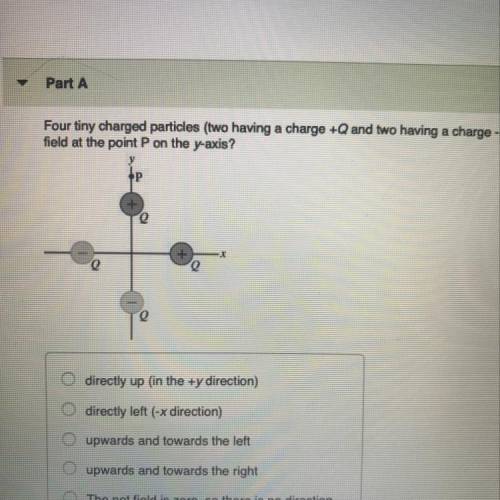
Physics, 27.05.2020 23:04, enrique3300
Four tiny charged particles (two having a charge +Q and two having a charge of -Q) are distributed on the X- and Y-axes as shown in the figure. Each charge is equidistant from the origin. In which direction is the net electric field at the point P on the y-axis?
A) directly up
B) directly left
C) upwards and towards the left
D) upwards and towards the right
E) The net field is zero, so there is no direction


Answers: 3
Other questions on the subject: Physics

Physics, 22.06.2019 08:30, katiemh8302
A17,250 kg rocket is pushed with a thrust of 6,450,284 n. what is the acceleration of the rocket?
Answers: 1

Physics, 22.06.2019 09:50, trobbie817
A250-n box is at rest on a frictionless horizotal floor. then a person shoves the box with a non-zero force of magnitude p. which statement best describes the relationship betweeen p and the motion of the box after it was shoved? -the box will not move when p< 250n but otherwise will accelerate at a constant rate that is directly proportional to p - the box will begin moving at a speed that is directly proportional to p, then will gradually slow to a halt -the box will move with constant velocity at a speed that is directly proportional to p -box will accelerate across the floor at a constant rate that is directly proportional to p
Answers: 1

Physics, 23.06.2019 00:30, gamallopatty
What is the coldest temperature ever recorded in san antonio?
Answers: 1

Physics, 23.06.2019 02:30, kbmom3830
Asatellite that goes around the earth once every 24 hours iscalled a geosynchronous satellite. if a geosynchronoussatellite is in an equatorial orbit, its position appearsstationary with respect to a ground station, and it is known as ageostationary satellite find the radius rof the orbit of a geosynchronous satellite that circles the earth.(note that ris measured from the center of the earth, not the surface.) you mayuse the following constants: the universal gravitational constant g is 6.67 \times 10^{-11}\; {\rm n \; m^2 / kg^2}. the mass of the earth is 5.98 \times 10^{24}\; {\rm kg}. the radius of the earth is 6.38 \times 10^{6}\; {\rm m}.
Answers: 2
Do you know the correct answer?
Four tiny charged particles (two having a charge +Q and two having a charge of -Q) are distributed o...
Questions in other subjects:


English, 22.09.2019 00:30


Mathematics, 22.09.2019 00:30




Mathematics, 22.09.2019 00:30


English, 22.09.2019 00:30






